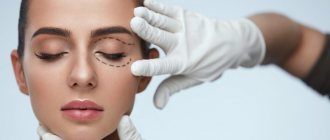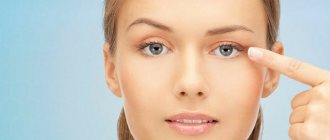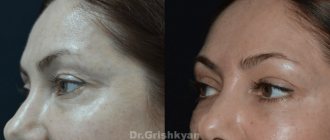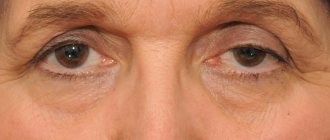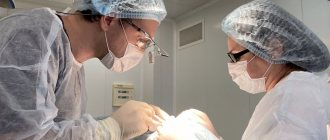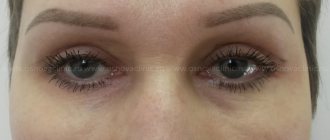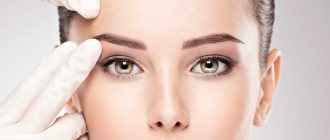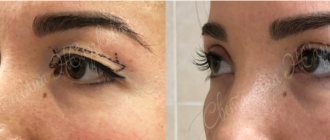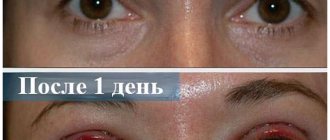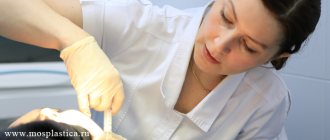Blepharoplasty is an operation performed to change the shape of the eyelids and the shape of the eyes. The postoperative period is short, occurs outside the hospital and does not require special rehabilitation measures. This is due to the fact that the operation involves affecting only the superficial tissues of the skin and has minimal impact on the body as a whole.
The time period from surgery to discharge ranges from a couple of hours to a day. The long-term postoperative period proceeds differently for each patient. The following factors influence this process:
- age;
- skin condition;
- skin type;
- structure of tissues around the eyes.
Most often, complete elimination of local and general disorders caused by surgery occurs two weeks after eyelid surgery. There is no pain syndrome. At the beginning of the recovery period, patients experience swelling and scarring, the presence of which patients should not worry about. This is a common occurrence for this type of operation.
Swelling after blepharoplasty and features of the postoperative period
All patients are concerned about significant swelling after blepharoplasty.
You should know that swelling is a normal reaction of the body to tissue damage and should not be a cause for concern. A cooling bandage and compresses help reduce swelling. Limiting physical activity and taking anti-inflammatory drugs also help speed recovery. Bruising after blepharoplasty is another inevitable consequence of plastic surgery. Hematomas do not require special treatment and go away on their own within two weeks. Approximately the same amount of time is needed for the complete disappearance of tissue edema, but the change in skin color in the periorbital area can last up to 3-4 weeks. But from about the tenth day you can already use decorative cosmetics, which help hide the marks of plastic surgery.
After blepharoplasty, patients complain of discomfort and a feeling of stiffness in the eyelid area. These symptoms do not require special treatment; it is enough to follow general recommendations. Pain in the eyes, increased sensitivity to light, dry eyes or watery eyes, and temporary changes in vision also often accompany blepharoplasty.
Antiseptic eye drops help moisturize the mucous membrane and prevent infectious complications. During the daytime outdoors, it is advisable to wear sunglasses or glasses with tinted lenses. It is necessary to regularly perform gymnastics for the extraocular muscles and the orbicularis oculi muscle.
You will have to give up contact lenses for a couple of months and return to regular glasses. For 2-3 weeks you need to limit physical activity. If possible, you should sleep on high pillows. During the entire recovery period, you should not visit the solarium or sauna. It is advisable to give up alcohol, coffee and smoking. You should not take medications without first consulting your doctor.
The exact recovery time depends on many factors: the method and extent of surgical correction, the patient’s age, the condition of the skin and soft tissues of the face and periorbital area.
Physiotherapeutic methods can speed up tissue regeneration. In our clinic, microcurrent therapy is actively used after eyelid surgery. Each patient after plastic surgery is provided with three free procedures. The results of blepharoplasty can be assessed after 2 months.
On the day of surgery
- The day before and on the day of surgery, do not use any cosmetics (eye cream, face cream, lipstick, etc.), or perfume.
- On the day of the operation, come to the clinic at the appointed time.
- You will sign a consent form for the operation and then your photograph will be taken. When planning upper eyelid surgery, the doctor will mark the upper eyelid with a marker.
- Then you take a sedative.
- After which you will sit on the operating table. The doctor will inject an anesthetic into the eyelids - lidocaine 1%.
Sutures after blepharoplasty
Sutures after blepharoplasty are not always applied; for example, with transconjunctival access, a cooling bandage and a patch on the eyelids are sufficient. Thanks to the excellent blood supply to the conjunctiva, the wound heals on its own in the shortest possible time.
If the surgical approach is through skin folds or along the ciliated edge of the eyelid, absorbable suture material is used. Minor scars remain after any operation, but after blepharoplasty they are not visible because they follow natural folds.
Preoperative preparation
- Two weeks before surgery, you should stop taking aspirin and drugs of this group.
- At least 10 days before surgery, you should stop taking NSAIDs, ginko biloba, vitamins E and C. Avoid alcohol 7 days before surgery.
- Three days before surgery, take Dicinon - 2 tablets 3 times a day, as well as another tablet in the morning on the day of surgery.
- Make sure that you are accompanied home after the operation, because... You won’t be able to drive the car yourself.
- On the eve of the operation, you should wash your hair and face. Wash thoroughly immediately before surgery.
Complications due to physician error
Asymmetry of the eyelids
Asymmetry is a doctor's mistake. Sometimes the defect goes away on its own, in other cases additional surgical intervention is required. Formed due to overcorrection of the skin or improper suturing.
The doctor has removed too much tissue, so one eye may appear smaller than the other. The operation is inevitable.
Poor quality seams
Incorrect suture placement is not only an aesthetic defect, it leads to suture divergence.
Poor quality stitching material leads to rupture and infection. In such cases, re-suturing is required.
The infection occurs due to violations of sanitation standards and non-compliance with medical recommendations during the recovery period.
Folds on the eyelids
Skin folds are formed due to the removal of excess fat. The defect is removed by repeated surgery.
Bad habits
Alcoholic drinks and cigarettes are two problems that, unfortunately, are familiar to a very large number of my patients.
No matter how long I talk about their harmful effects on the body. No matter how much you talk about the risks. All the same, heavy smokers relapse. And many believe that “two sips will do nothing at the holiday.”
Once again I urge you to be patient. Rehabilitation after blepharoplasty does not last a year, or even six months.
Avoid cigarettes and alcohol for at least a month. And enjoy your rejuvenated, refreshed eyes!
Here you can make an appointment with me for a consultation. I will be happy to answer your questions!
Causes of chemosis of the conjunctiva of the eye
- Allergy
- Trauma (foreign body in the eye)
- Conjunctivitis (inflammation of the conjunctiva)
- Blepharitis (inflammation of the eyelids)
- Barley (infectious disease) and others.
Eliminating the cause that caused chemosis means eliminating the very cause that caused the swelling. If you do not begin to treat this inflammatory process on time, then there may be a disruption in the nutrition of the tissues of the cornea (the transparent part of the outer shell of the eye), which leads to the development of infections and deterioration of vision.
Answers to basic questions
When are the stitches removed?
On the first day, the woman/man is under the supervision of nurses and a doctor for 1–3 hours. The sutures are removed after 4–7 days. It all depends on the depth of the cut.
Will scars be visible on the eyelids?
Sutures are placed as close to the eyelash line as possible. After lower blepharoplasty they are almost invisible. After the end of the recovery period, they completely resolve.
After upper eyelid surgery, the sutures are more noticeable. They won't disappear in a month. It should take 12 weeks for the color to completely smooth out and even out. If scars remain after 3 months, physical therapy is performed to remove them.
When can you wear makeup after blepharoplasty?
Cosmetics can be applied 14 days after surgery. To avoid allergic reactions, since the skin is very sensitive during this period, select hypoallergenic cosmetics. Choose products from reliable brands recommended by your doctor.
Cosmetics should be light and soft. It is strictly forbidden to apply to the crust covering the surface of the wound, or to areas of irritation.
How long does it take to fully recover after blepharoplasty?
Takes 10–12 weeks. Photos of rehabilitation by day with explanations below.
A person can go home on the first day after the procedure. Severe swelling appears above and below the eyes, which can spread to the nose and area around the eyes.
2–3 days after the cosmetic procedure the swelling is slightly less. Take antiseptic drops and perform eye exercises.
A preventive examination is carried out on days 4–5. Contact lenses can be used.
On day 5, hematomas and swelling begin to subside. The skin under the patches itches. But you shouldn’t touch your eyes with your hands, much less scratch them.
6-7 days - the sutures are removed. The eye swells a little. The cyanosis disappears. Some sutures are self-dissolving, you need to come to an appointment.
On the 10th day, hemorrhages resolve. It is allowed to use cosmetics if the stitches dissolve.
After 2 weeks, the effect of the operation is almost invisible. The stitches are coming through.
40–45 days - recovery comes to an end. The effect of surgery remains noticeable.
By the end of 3 months, the sutures are completely dissolved.
What are the restrictions after blepharoplasty?
Blepharoplasty is a type of plastic surgery to correct cosmetic imperfections. 90% of success depends on the correct behavior of patients, so the following restrictions should be adhered to:
- sleep in a reclining position to prevent swelling;
- do not lift heavy objects or do bended work;
- eat as usual, avoid alcohol, smoking and spicy foods;
- do not wet the seams too much;
- do not remove the adhesive bandages yourself and do not pull out the threads;
- drink less fluid;
- give up contact optics for several months;
- do not visit the solarium, sauna and steam room;
- limit the consumption of coffee and tea;
- Do not use medications without prior consultation.
How long will the effect of blepharoplasty last?
Surgery of the upper and lower eyelids is characterized by good and lasting results. The duration of the effect depends on lifestyle.
Plastic surgeons claim that the result lasts up to 10 years, but practice shows that the effect lasts up to 5 years.
How long after you can have repeat blepharoplasty?
Repeated surgery is permitted if there are contraindications. Plastic surgeons do not recommend doing blepharoplasty more than 3 times in a lifetime.
Repeated surgery is performed after 3–4 months, when the initial sutures have completely healed.
Reviews
Irina, 36 years old
I take a very responsible approach to all my plans, especially when it comes to my appearance. Here I am especially scrupulous. Therefore, after deciding to have blepharoplasty, I was puzzled by the question: when is the best time to do it. I only had vacations in the summer and autumn. So I decided to ask my doctor this question. He advised me to have the operation in the fall, because if I had it in the summer, I would not be able to fully enjoy the trip to the sea. Or I'll have to spend all my time in the shadows. Moreover, in the heat it will also be much more difficult to endure rehabilitation. I had the operation on his recommendation, and in the summer I swam in the sea with all my might.
Blepharoplasty after 50 years
At this age, the realization that youth is passing no longer scares people, but the desire to look well-groomed remains. Of course, everything is individual, but the effect of isolated blepharoplasty in people over fifty will not be so noticeable, and it will not last long (about a year).
Therefore, plastic surgeons often recommend resorting to a circular facelift using a technique selected based on the patient’s characteristics. Six months after the facelift, when the final result of the procedure is visible, you can resort to blepharoplasty. In this combination, the effect of the procedure will be impressive and long-lasting.
What time of year is best to have blepharoplasty?
To protect yourself as much as possible from the side effects of surgical tightening of the area around the eyes and to shorten the rehabilitation period, it is better to plan the procedure in advance for autumn or winter. After blepharoplasty, direct sunlight on postoperative sutures is strictly prohibited for 3-4 months.
Any “immature” scar under the influence of ultraviolet radiation can become hyperpigmented. This process is irreversible, therefore, even after surgery performed during a season with short daylight hours, it is necessary to protect the operated area with sunglasses and use high-quality products with SPF.
Gymnastics for the eyes and eyelid massage after blepharoplasty
Eye exercises are an important part of the rehabilitation period. Gymnastics strengthens muscles, removes excess water and relieves swelling.
Some useful exercises:
- eye movements in different directions;
- drawing numbers, letters and figures in the air;
- squeeze and open your eyes wide.
Massage is performed to quickly get rid of swelling and bruises. It improves microcirculation and lymph outflow from damaged tissues. Due to lymphatic drainage massage, hemorrhages resolve faster and sutures heal better.
